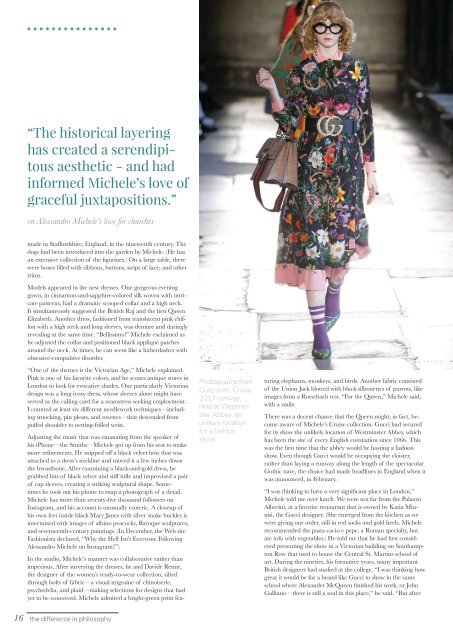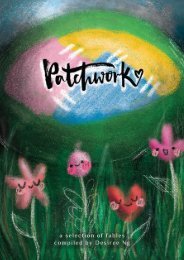DifferentMagazine
Create successful ePaper yourself
Turn your PDF publications into a flip-book with our unique Google optimized e-Paper software.
“The historical layering<br />
has created a serendipitous<br />
aesthetic - and had<br />
informed Michele’s love of<br />
graceful juxtapositions.”<br />
on Alessandro Michele’s love for churches<br />
made in Staffordshire, England, in the nineteenth century. The<br />
dogs had been introduced into the garden by Michele. (He has<br />
an extensive collection of the figurines.) On a large table, there<br />
were boxes filled with ribbons, buttons, strips of lace, and other<br />
trims.<br />
Models appeared in the new dresses. One gorgeous evening<br />
gown, in cinnamon-and-sapphire-colored silk woven with intricate<br />
patterns, had a dramatic scooped collar and a high neck.<br />
It simultaneously suggested the British Raj and the first Queen<br />
Elizabeth. Another dress, fashioned from translucent pink chiffon<br />
with a high neck and long sleeves, was demure and daringly<br />
revealing at the same time. “Bellissimo!” Michele exclaimed as<br />
he adjusted the collar and positioned black appliqué patches<br />
around the neck. At times, he can seem like a haberdasher with<br />
obsessive-compulsive disorder.<br />
“One of the themes is the Victorian Age,” Michele explained.<br />
Pink is one of his favorite colors, and he scours antique stores in<br />
London to look for evocative shades. One particularly Victorian<br />
design was a long ivory dress, whose sleeves alone might have<br />
served as the calling card for a seamstress seeking employment.<br />
I counted at least six different needlework techniques—including<br />
smocking, pin pleats, and rosettes—that descended from<br />
puffed shoulder to netting-frilled wrist.<br />
Adjusting the music that was emanating from the speaker of<br />
his iPhone—the Smiths—Michele got up from his seat to make<br />
more refinements. He snipped off a black velvet bow that was<br />
attached to a dress’s neckline and moved it a few inches down<br />
the breastbone. After examining a black-and-gold dress, he<br />
grabbed bits of black velvet and stiff tulle and improvised a pair<br />
of cap sleeves, creating a striking sculptural shape. Sometimes<br />
he took out his phone to snap a photograph of a detail.<br />
Michele has more than seventy-five thousand followers on<br />
Instagram, and his account is unusually esoteric. A closeup of<br />
his own feet inside black Mary Janes with silver snake buckles is<br />
intermixed with images of albino peacocks, Baroque sculptures,<br />
and seventeenth-century paintings. (In December, the Web site<br />
Fashionista declared, “Why the Hell Isn’t Everyone Following<br />
Alessandro Michele on Instagram?”)<br />
Photographs from<br />
Gucci.com, Cruise<br />
2017 runway,<br />
held at Westminster<br />
Abbey, an<br />
unlikely location<br />
for a fashion<br />
show<br />
In the studio, Michele’s manner was collaborative rather than<br />
imperious. After surveying the dresses, he and Davide Renne,<br />
the designer of the women’s ready-to-wear collection, sifted<br />
through bolts of fabric—a visual migraine of chinoiserie,<br />
psychedelia, and plaid—making selections for designs that had<br />
yet to be conceived. Michele admired a bright-green print featuring<br />
elephants, monkeys, and birds. Another fabric consisted<br />
of the Union Jack blotted with black silhouettes of parrots, like<br />
images from a Rorschach test. “For the Queen,” Michele said,<br />
with a smile.<br />
There was a decent chance that the Queen might, in fact, become<br />
aware of Michele’s Cruise collection. Gucci had secured<br />
for its show the unlikely location of Westminster Abbey, which<br />
has been the site of every English coronation since 1066. This<br />
was the first time that the abbey would be hosting a fashion<br />
show. Even though Gucci would be occupying the cloister,<br />
rather than laying a runway along the length of the spectacular<br />
Gothic nave, the choice had made headlines in England when it<br />
was announced, in February.<br />
“I was thinking to have a very significant place in London,”<br />
Michele told me over lunch. We were not far from the Palazzo<br />
Alberini, at a favorite restaurant that is owned by Katia Minniti,<br />
the Gucci designer. (She emerged from the kitchen as we<br />
were giving our order, still in red socks and gold heels. Michele<br />
recommended the pasta cacio e pepe, a Roman specialty, but<br />
ate tofu with vegetables.) He told me that he had first considered<br />
presenting the show in a Victorian building on Southampton<br />
Row that used to house the Central St. Martins school of<br />
art. During the nineties, his formative years, many important<br />
British designers had studied at the college. “I was thinking how<br />
great it would be for a brand like Gucci to show in the same<br />
school where Alexander McQueen finished his work, or John<br />
Galliano—there is still a soul in this place,” he said. “But after<br />
16 the difference in philosophy





